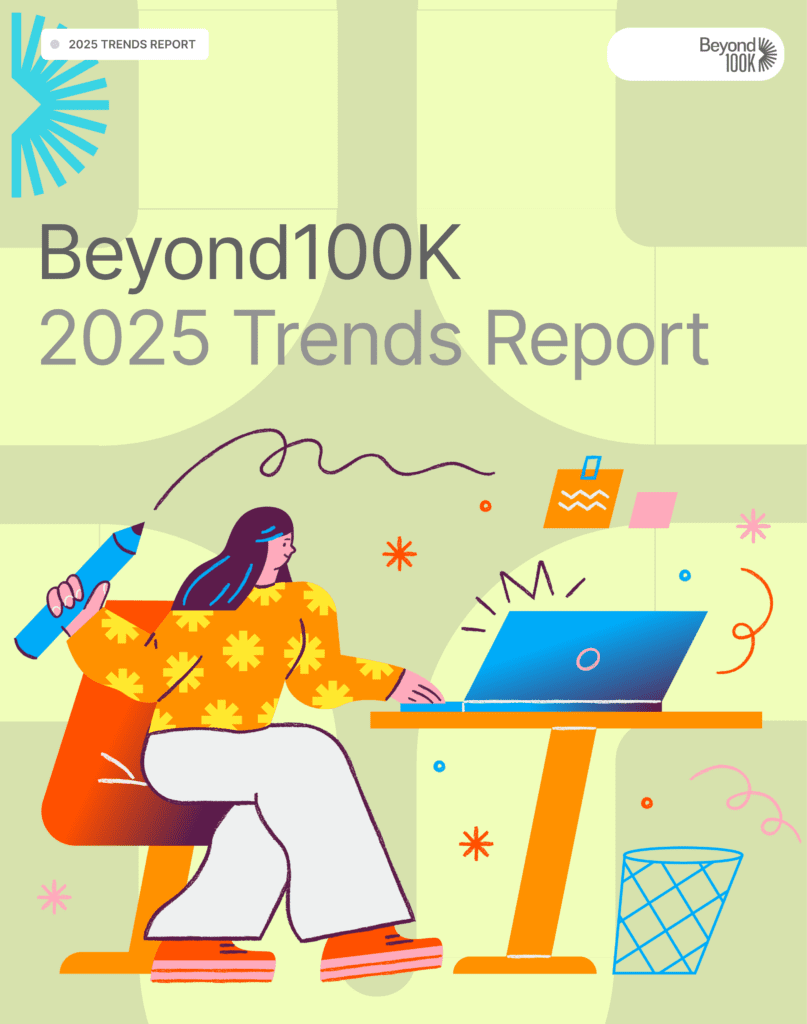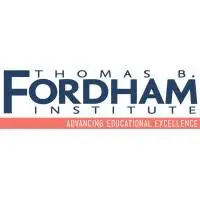In 2025, we are navigating profound shifts—policy changes, funding instability, and a growing urgency to prepare the next generation of problem solvers, innovators, engineers, and scientists in an increasingly complex world. Yet even in the face of these challenges, across the Beyond100K network, we see organizations adapting, innovating, and holding firm in their commitment to expanding opportunity.
The significance of this work has never been clearer: equal access to education is not just a moral imperative—it is a strategic necessity. Our nation’s economic strength, technological leadership, and capacity for innovation depends on ensuring that all students, regardless of background, have access to high-quality STEM learning. The choices we make today will define our ability to fuel scientific breakthroughs and build a thriving future workforce.
As a network of changemakers, Beyond100K has a unique view of the field. This year’s Trends Report captures what we’re hearing directly from our partners, the real time shifts, emerging patterns, and the undercurrents shaping STEM education. It highlights five key themes shaping STEM education today, trends that reinforce our shared responsibility to ensure STEM teaching and learning thrive, even amidst political and economic uncertainty.
At its core, this report is more than an assessment—it is a call to action. We must stand united, align our efforts, and share knowledge to ensure a robust and diverse STEM teacher workforce that will lead to greater opportunity for our nation’s children. The stakes are high, but so is our collective resolve. The way forward is through working together, turning toward each other, and strengthening our shared commitment. Together, we can turn today’s challenges into the momentum needed to drive progress for all.

A defining trend of the past year has been the shift from questioning if educators should use artificial intelligence in STEM education to focusing on how to integrate it responsibly, equitably, and effectively. Educators, policymakers, and industry leaders are moving beyond curiosity and concern, toward implementation, grappling with practical applications, ethical considerations, and the potential impact on teaching and learning.
While there is broad consensus among network partners that AI literacy is essential for both students and teachers, perspectives vary on the best path forward. Some partners emphasize immediate classroom applications, while others focus on long-term structural changes in teacher preparation and professional development programs.
Beyond100K partners are actively shaping AI education in ways that prioritize responsible and equitable implementation. The American Federation of Teachers (AFT) recently announced new guardrails for AI use in classrooms, ensuring ethical considerations are embedded in adoption strategies. Meanwhile, Digital Promise is leading initiatives on AI and digital equity, ensuring that the rapid adoption of AI does not exacerbate existing disparities. The Colorado Education Initiative (CEI) and The California Department of Education are designing and launching AI frameworks and state-level playbooks with their respective departments alongside partners like aiEDU and others.
AI-powered tools have the potential to assist with differentiated instruction, automate administrative burdens that contribute to teacher burnout, and provide real-time insights to support student-level learning. The key will be ensuring that educators are at the center of AI integration, equipped with the knowledge, resources, and agency to use these tools in ways that enhance learning and expand opportunities for all students.
Looking ahead, the next phase of this trend will be defined by critical decisions about funding and access that will ensure AI tools serve as a force for equity rather than an exacerbator of existing divides. While concerns around digital equity remain – especially in terms of who has access to high-quality AI tools and training – AI also presents an opportunity to address long-standing challenges in education.

Conversations about mentorship in teacher preparation are not new, but a clear trend has emerged this year: Mentorship is gaining renewed recognition as a cornerstone of teacher preparation and retention, particularly as apprenticeships, residencies, and grow-your-own (GYO) programs expand. These initiatives depend on experienced educators to serve as mentors, playing a pivotal role in shaping the next generation of STEM teachers.
Across the Beyond100K network, partners are embedding mentorship into teacher preparation and early-career development. Beyond100K partners EnCorps and the Los Angeles Unified School District (LAUSD) just launched a two-year Broad-funded partnership to embed mentor support into Career and Technical Education (CTE) teacher training and provide real-time coaching to improve retention. Notre Dame of Maryland University is piloting a school-based teacher mentorship program to ensure that new teachers receive structured, ongoing support. Additionally, organizations like Ignited, Community Resources for Science (CRS), and the New York Academy of Sciences are fostering scientist-teacher partnerships that provide teachers with authentic STEM industry experiences to bring back to their classrooms.
Meanwhile, other partners are leveraging mentorship to not only strengthen the teacher pipeline, but also to increase educator retention and address the unique challenges faced by Black, Latine, and Indigenous educators. Edifying Teachers, has developed a mentorship model focused on Culturally Sustaining Conversations, Collaboration, and Career Navigation. Their work responds to research showing that mentorship can cut teacher attrition by more than half, particularly when it goes beyond instructional coaching to include professional growth and community-building.
As these programs scale, they strengthen professional pathways for new educators, but they also create potential bottlenecks as teacher attrition rates remain high. Programs like the Opportunity Culture Initiative offer models for how mentor teachers can take on leadership roles while remaining in the classroom, providing a blueprint for differentiated pay and career advancement. Looking ahead, we predict that districts and states will need to treat mentorship not as an optional support structure but as a fundamental part of solving the STEM teacher shortage.

As systemic barriers to equity intensify—from the Supreme Court’s decision against affirmative action in 2023 to the recent threats to federal education funding—many students, particularly those from marginalized communities, continue to face limited access to high-quality STEM learning. For generations, education has been the gateway to opportunity, a fundamental promise of the American Dream—the idea that all people, regardless of background, should have the chance to succeed. These recent attacks on targeted programs put that dream at risk, increasing the likelihood of deepening the existing disparities in STEM education.
Despite these challenges, we are hearing from partners that they remain steadfast in their commitment to expanding and deepening equitable access. Beyond100K Project Teams, which bring together educators, researchers, and practitioners to develop innovative solutions to systemic STEM education challenges, are actively addressing equity barriers. Teams such as “Cultivating Inclusive STEM Curriculum” and “What Does Socially-Just STEM School Administration Look Like?” are finding practical ways to advance equity without getting lost in debates over terminology.
The California STEM Network has introduced an equity framework to guide policymakers and practitioners, ensuring that underrepresented students remain at the center of STEM education initiatives. Meanwhile, Loyola University Chicago is helping educators integrate belonging-focused practices into their STEM curricula through action, research, and peer collaboration.
Across sectors, including education, government, and philanthropy, pressure is mounting for partners and the broader STEM field to censure language related to diversity, equity, and inclusiveness. While political forces use language to shape funding decisions and restrict opportunity, our partners remain focused on the values that drive our shared work: ensuring that all students have access to the same high-quality education, resources, and support as their peers.
In the year ahead, we predict we will need to remind the nation of the meaning behind the words being censured: We need diversity because it fuels innovation, strengthens our economy, enriches problem-solving, and ensures that all perspectives are represented in shaping the future. Equitable access to education means that every student, regardless of their background, income, or identity, has the resources, opportunities, and support needed to reach their full potential. When STEM is inclusive, innovation flourishes, problem-solving becomes more effective, and all students see themselves as capable contributors to the future of science, technology, engineering, and math.
We will need to hold firm to our work, find solutions to counter efforts that seek to limit opportunity, and ensure that policies aimed at excluding our most vulnerable students do not succeed in limiting our collective future.

Even before this year began with significant policy shifts, we saw a trend in partners increasingly expressing interest in how they might advocate or influence policy that impacted their work. Partners expressed concerns about how shifting political priorities—including limitations on language, changes in federal funding, and state-level policy shifts—could disrupt their efforts and are seeking out support to proactively affect their policy landscape.
Some Beyond100K partners are already engaging with policymakers and shaping the future of STEM education. The Internationals Network is strengthening coalitions to advocate for policies that protect immigrant and refugee multilingual learners and ensure they have access to quality STEM education.
Partners who do not have prior experience in policy work expressed a desire to learn from those for whom it is core to their mission. While interest in policy and advocacy was already growing, many recent changes pose existential threats to the education sector. We anticipate that urgency will rise across the field, pushing more organizations to make their voices heard, whether through direct engagement with legislators, amplifying on-the-ground insights, raising awareness for key issues, or developing research-driven recommendations. The question is no longer whether to engage, but how to most effectively coordinate to protect progress and ensure that STEM education remains a national priority.

Even before recent federal funding freezes and cuts added greater urgency, partners were already feeling the effects of economic instability, political shifts, and the expiration of pandemic-era education funding. The loss of Elementary and Secondary School Emergency Relief (ESSER) funds has left school districts struggling to sustain programs, while shifts in philanthropic priorities away from education have introduced additional financial uncertainty. The recent federal funding cuts have been particularly devastating, as government funding made up about 33% of nonprofit revenue. Additionally, partners observed increased caution from private philanthropy for work addressing challenges faced by specific demographic groups—such as initiatives supporting STEM access for girls or immigrant students—adding yet another layer of financial strain.
With funding priorities continuing to shift and federal funding unreliable, our network partners are thinking creatively about how to navigate a shifting landscape, from deepening local partnerships to exploring earned revenue models, and bipartisan state funding allocations, the work carries forth. Others are leaning into collaboration, recognizing that more can be gained together than through competition for limited resources.
Beyond100K Collaboration Grants—small, quick-turnaround grants that cover travel and meeting expenses to facilitate in-person connections between partner organizations—are enabling partners to exchange ideas, observe each other’s work, and explore potential collaborations. Beyond100K partners KQED and Science Friday will utilize their collaboration grant to develop their fundraising strategy for the development of joint youth voice-focused science communication efforts and related programming.
In 2025, we anticipate that education will face increasing competition for attention and funding, as urgent crises continue to dominate the national landscape. While immediate crises may seem more pressing, underinvesting in STEM education today risks creating tomorrow’s emergency: a critical workforce shortage that could derail innovation, research, and economic growth. The foundations of our future STEM workforce are being laid in today’s K-12 classrooms, and decisions about educational funding made this year will reverberate for generations.
Without sustained investment—particularly in addressing the STEM teacher shortage—we risk falling behind in global innovation and technological advancement. Public-private partnerships, new funding models, and creative resource allocation will be essential in ensuring that funding limitations do not curtail progress.
Conclusion
The 2025 Trends Report highlights both the challenges and the collective momentum shaping STEM education today. Across the field, educators, policymakers, and organizations are navigating uncertainty, grappling with the rapid integration of AI, evolving political and funding landscapes, and the ongoing challenge of expanding equal access to STEM learning. These forces are impacting classrooms and influencing how the field prepares the next generation of STEM educators and future leaders.
Despite these challenges, we are seeing patterns of persistence and adaptation. Educator preparation programs, nonprofits, and districts are scaling mentorship to support more teachers and organizations are reframing language to focus on shared values. AI is no longer a theoretical conversation but a pressing reality, demanding careful attention to both opportunity and risk. At the same time, advocacy is emerging as an essential tool for ensuring that policies reflect the needs of educators and students.
Looking ahead, the choices made today will have lasting consequences. Progress in expanding access, supporting educators, and sustaining STEM learning in the face of adversity reinforces a crucial truth. Meaningful change is not achieved in isolation. It is built through collaboration, persistence, and a shared vision for the future.
As we look ahead, one thing is clear: this work is more important than ever, and so is this community. The path forward is not guaranteed, but our collective commitment ensures we are moving in the right direction. The question before us now is simple—will we keep pushing forward? Together, we have the power to make sure the answer is yes.




